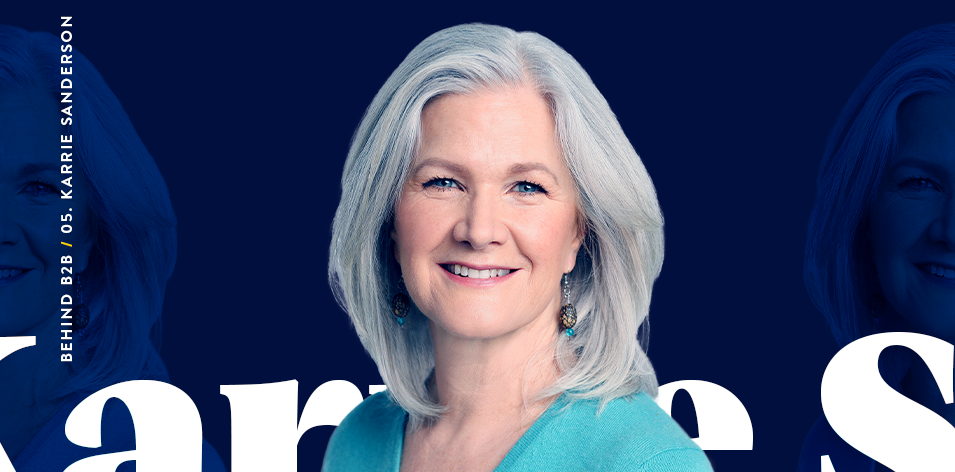

For the fifth instalment of Behind B2B, our series exploring the brightest minds in the industry, we meet Karrie Sanderson – branding expert, Smartsheet marketing leader and experienced sailor.
How many marketers have degrees in industrial engineering? Our guess: not many. But as Karrie Sanderson proves, it’s a background that offers a unique and powerful approach to brand building and insight. Now working as Vice President, Marketing Insights and Brand for Smartsheet, we sat down with Karrie to hear about her unconventional journey into the world of B2B marketing.
In high school, I was a keen writer – my dream was actually to be an investigative journalist. I also had a strong aptitude for math and science, so my high school guidance counsellor challenged me to pursue a STEM career. But almost in a way that felt like, oh, you’ll never really do it.
If somebody suggests I can’t do something, I always want to prove them wrong. I ended up getting a degree in Industrial Engineering, which I really enjoyed. But even while I was studying, I used my writing skills to make some spending cash – helping engineers who weren’t so strong at writing or editing their work.
My first job out of grad school was for a company that made different products for restaurants. I’d studied engineering, obviously, but I was curious about all of the different business areas. I asked: is there some kind of department rotation where I can understand more of what’s going on across the organisation? And so I ended up in the marketing department.
Any newbie marketer was immediately put to work on these fairly unglamorous B2B products. But I’m grateful – it gave me a really strong discipline of thinking about multi-layered audiences.
In B2C, it feels like you’re mostly thinking about one audience. With B2B, you have to think about all the stakeholders along the way, what their needs are, how to position products to them. How to market to multi-layered audiences in a way that’s connected and cohesive, but also speaks to them on a targeted level. In many ways, I was using the analytical and research skills so central to engineering.
Yes – once I hit the marketing department, I figured out: here’s where my right brain and left brain can come together. And of course, having a technical background has allowed me to work confidently in some fairly technical fields. Like paper, healthcare, beverages, pharmaceuticals – and now SaaS. When you market those products, you have to really be able to grasp the complexities and learn about what you’re marketing.
As an engineer-turned-marketer, my power is really on the strategic side. Everything I do has a strong foundation of research and insight. I see patterns and frameworks everywhere. That’s helped me immensely with my focus areas of brand building and brand activation. Figuring out brand architecture, where we fit in the market, how we stack against competitors – I naturally just see those things.
Which is helpful. I see the benefits all the time at Smartsheet. I think frameworks actually allow creativity to thrive, if you give people the rules of the world to play and build in. If you give people the guardrails, creativity can grow from that.
One thing I’m hugely proud of at Smartsheet is our sponsorship of Pip Hare. Pip is this incredible sailor who was looking to compete in the Vendée Globe race – a solo, non-stop round-the-world yacht race.
Brand sponsorship is tricky, in B2B especially. You really have to make sure you’re bringing that sponsorship to life. It needs to align with the brand, it needs to make logical sense, and you have to activate it in a way that makes people feel an emotional connection.
When the Pip opportunity came on the radar, the first thing I did was go back to the new brand architecture we’d been developing – and specifically, the emotional part of our architecture. Our customers tell us that when you understand the power of Smartsheet, you’re unlocking this hero moment of saying: right, I can do this. I can tackle the impossible. And that’s exactly what the spirit of Pip’s story is.
So the stars just aligned – I couldn’t have made up a better story to sponsor. It was a beautiful brand fit, and she’s an amazing person. Brand sponsorship was a new thing for Smartsheet, but we activated all along the way, from having her speak at our annual ENGAGE customer event, to promotion along our PR, social, and other customer channels. And of course, Pip and her team tapped into Smartsheet solutions to streamline their work and share progress.
Yes – my husband and I race, and we’re also cruiser sailors. Along with our two kids, we actually took a two year ‘sailing sabbatical’ a few years ago.
That was an incredible experience. We got to know each other so well. And it taught us the importance of being resourceful – when you’re sailing in the middle of nowhere, you can’t just get online and order a part, you have to figure it out. You eat what you catch, or what’s available at the little market when you head to shore. You learn to do more with less, to be comfortable in silence.
I’m impressed by really solid brand work. It’s from a while back but one example that still sticks with me is BASF, the chemical company. Namely: We don’t make a lot of the products you buy. We make a lot of the products you buy better.
Marketing chemicals is hard; nobody wants to think about the chemicals in their products! But they flipped the script and made these really captivating ads that raised brand awareness in this clever B2B2C way. All these years later, it’s still in my head.
Intel Inside is another example of a brand that does that well. They’re B2B – they’re not selling chips directly to the consumer. But the consumer is still looking for the Intel logo. The Intel sticker makes you feel confident in a product and gives a brand boost to whichever computer they are inside.
There’s a lot B2B can learn from B2C and vice versa, particularly since, as you say, it feels like so much now is in this ‘B2B2C’ mode. Even if you have a pure B2C brand, there’s a chance you’re also selling it through some other distributor. Everybody’s got a B2B2C component.
And so it goes back to my earlier comment about the layers of the audience. With Smartsheet, we’re selling to the business – but ultimately it’s people who use the platform, so you have to figure out how to tap into that individual who would ask for Smartsheet to be implemented. If they’re moving to a new job, how do you get them to feel so connected to Smartsheet that they take it with them? How do you make that connection on a human level, but also at a business level?
That’s something for B2B to learn from B2C: make sure you’re focused on the needs of the person using what you’re selling. Conversely, B2C needs to be more like B2B in thinking about multi layered audience needs. Considering what everyone on the value chain needs, and how you can align messages so that they feel seamless and connected.
Specifically in SaaS marketing, I’d get rid of the idea of the elusive ‘enterprise’ customer – you know, some monolithic impersonal enterprise buyer who somehow personifies who you’re trying to speak to. It can feel like B2B is building-to-building marketing! When you fall into that thinking, you stop speaking to people like humans. They just end up being the conduit to a business goal.
Always speak to people on human terms – it’s the best way to connect emotionally. So I guess that’s not really a ‘trope’, more of a ‘trap’ to avoid falling into. But it’s important, either way.
The latest (and most useful) B2B insight, delivered to your inbox.
Publicis Pro needs the contact information you provide to send you the latest B2B insights. You may unsubscribe from these communications at anytime.